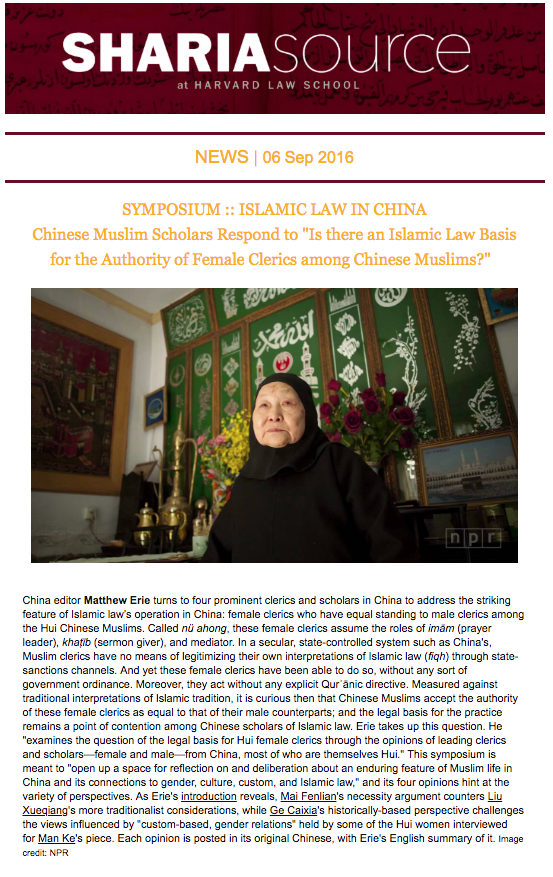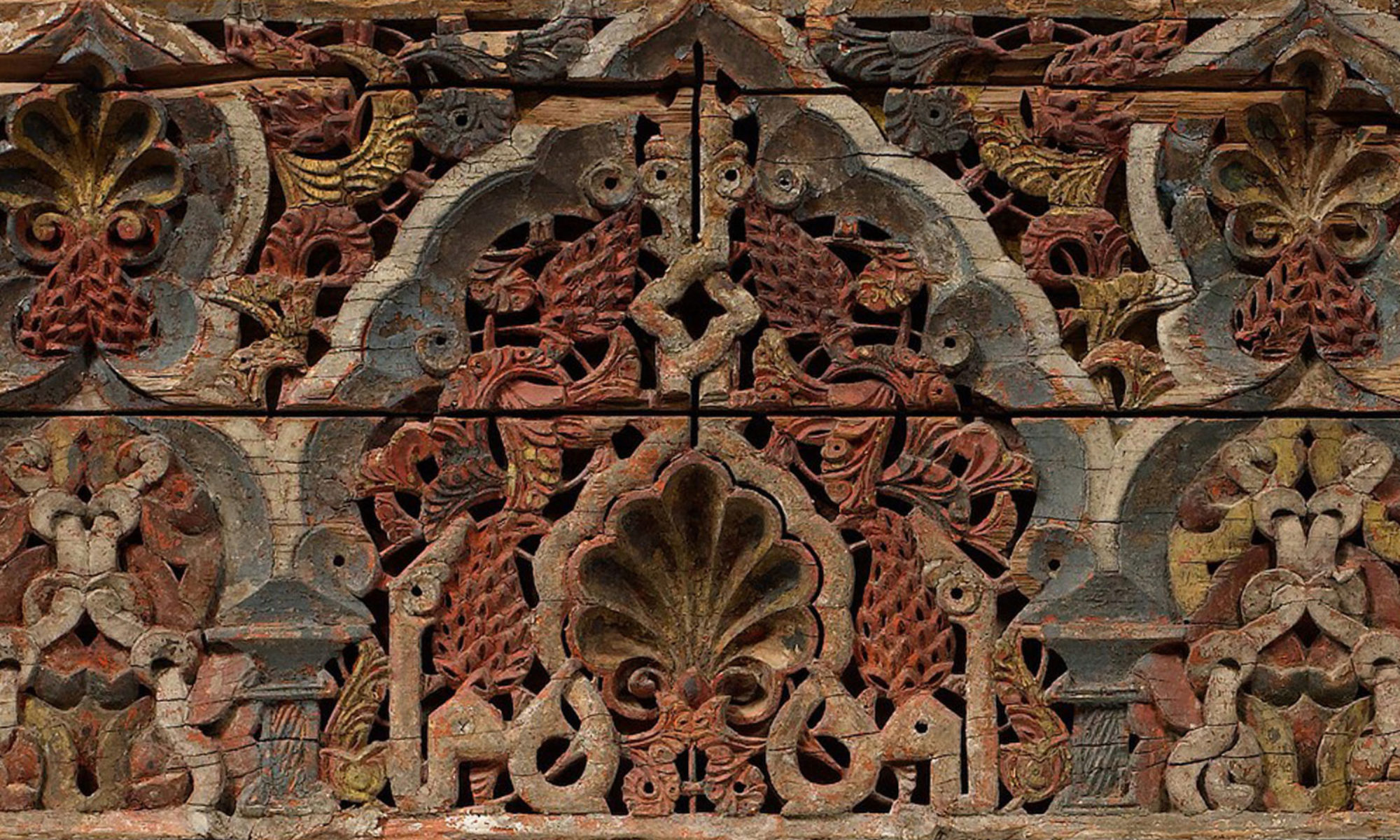
 SYMPOSIUM :: ISLAMIC LAW IN CHINA Chinese Muslim Scholars Respond to “Is there an Islamic Law Basis for the Authority of Female Clerics among Chinese Muslims?” China editor Matthew Erie turns to four prominent clerics and scholars in China to address the striking feature of Islamic law’s operation in China: female clerics who have equal standing to male clerics among the Hui Chinese Muslims. Called nü ahong, these female clerics assume the roles of imām (prayer leader), khaṭīb (sermon giver), and mediator. In a secular, state-controlled system such as China’s, Muslim clerics have no means of legitimizing their own interpretations of Islamic law (fiqh) through state-sanctions channels. And yet these female clerics have been able to do so, without any sort of government ordinance. Moreover, they act without any explicit Qurʾānic directive. Measured against traditional interpretations of Islamic tradition, it is curious then that Chinese Muslims accept the authority of these female clerics as equal to that of their male counterparts; and the legal basis for the practice remains a point of contention among Chinese scholars of Islamic law. Erie takes up this question. He “examines the question of the legal basis for Hui female clerics through the opinions of leading clerics and scholars—female and male—from China, most of who are themselves Hui.” This symposium is meant to “open up a space for reflection on and deliberation about an enduring feature of Muslim life in China and its connections to gender, culture, custom, and Islamic law,” and its four opinions hint at the variety of perspectives. As Erie’s introduction reveals, Mai Fenlian‘s necessity argument counters Liu Xueqiang‘s more traditionalist considerations, while Ge Caixia‘s historically-based perspective challenges the views influenced by “custom-based, gender relations” held by some of the Hui women interviewed for Man Ke‘s piece. Each opinion is posted in its original Chinese, with Erie’s English summary of it. Image credit: NPR
SYMPOSIUM :: ISLAMIC LAW IN CHINA Chinese Muslim Scholars Respond to “Is there an Islamic Law Basis for the Authority of Female Clerics among Chinese Muslims?” China editor Matthew Erie turns to four prominent clerics and scholars in China to address the striking feature of Islamic law’s operation in China: female clerics who have equal standing to male clerics among the Hui Chinese Muslims. Called nü ahong, these female clerics assume the roles of imām (prayer leader), khaṭīb (sermon giver), and mediator. In a secular, state-controlled system such as China’s, Muslim clerics have no means of legitimizing their own interpretations of Islamic law (fiqh) through state-sanctions channels. And yet these female clerics have been able to do so, without any sort of government ordinance. Moreover, they act without any explicit Qurʾānic directive. Measured against traditional interpretations of Islamic tradition, it is curious then that Chinese Muslims accept the authority of these female clerics as equal to that of their male counterparts; and the legal basis for the practice remains a point of contention among Chinese scholars of Islamic law. Erie takes up this question. He “examines the question of the legal basis for Hui female clerics through the opinions of leading clerics and scholars—female and male—from China, most of who are themselves Hui.” This symposium is meant to “open up a space for reflection on and deliberation about an enduring feature of Muslim life in China and its connections to gender, culture, custom, and Islamic law,” and its four opinions hint at the variety of perspectives. As Erie’s introduction reveals, Mai Fenlian‘s necessity argument counters Liu Xueqiang‘s more traditionalist considerations, while Ge Caixia‘s historically-based perspective challenges the views influenced by “custom-based, gender relations” held by some of the Hui women interviewed for Man Ke‘s piece. Each opinion is posted in its original Chinese, with Erie’s English summary of it. Image credit: NPR
 SYMPOSIUM :: The Case for Female Clerics in Islamic Law: Textual Bases,Old and New, Religious and Secular Mai Fenlian (买粉连) is a former cleric who argues that there is a textual basis in Islamic law for female clerics. She suggests that evidence can be found in the Qurʾān and ḥadīth (prophetic reports) supporting “women’s equal footing in religious life” and legitimizing “women’s activities in social activities, from education to war.” To be sure, she hedges the textual argument with an argument about the benefits, commenting that having more knowledgeable Hui women would lead to “more harmonious families and communities.” Another scholar, Ge Caixia (葛彩霞), also uses Islamic law texts as the basis for her main argument in favor of female clerics’ authority, citing a ḥadīth relaying that “the Prophet Muhammad’s wife Aisha taught Islamic law, among other topics, to women.” She complements the Islamic law texts with an argument from modern Chinese law, which “defines the requirements for an ‘Islamic staff member’ [to be] gender-blind.” Image credit: BBC
SYMPOSIUM :: The Case for Female Clerics in Islamic Law: Textual Bases,Old and New, Religious and Secular Mai Fenlian (买粉连) is a former cleric who argues that there is a textual basis in Islamic law for female clerics. She suggests that evidence can be found in the Qurʾān and ḥadīth (prophetic reports) supporting “women’s equal footing in religious life” and legitimizing “women’s activities in social activities, from education to war.” To be sure, she hedges the textual argument with an argument about the benefits, commenting that having more knowledgeable Hui women would lead to “more harmonious families and communities.” Another scholar, Ge Caixia (葛彩霞), also uses Islamic law texts as the basis for her main argument in favor of female clerics’ authority, citing a ḥadīth relaying that “the Prophet Muhammad’s wife Aisha taught Islamic law, among other topics, to women.” She complements the Islamic law texts with an argument from modern Chinese law, which “defines the requirements for an ‘Islamic staff member’ [to be] gender-blind.” Image credit: BBC
 SYMPOSIUM :: The Case Against Female Clerics in Islamic Law: A Cultural Basis Does Not a Legal Basis Make Cleric Liu Xueqiang (刘学强) examines arguments rooted in cultural norms to find a legal basis for female clerics. He concludes that “female clerics originate[d] in the particular historical-cultural environs of the Central Plains of China,” out of the region’s “traditions of scriptural education.” For him, though, these origins are at odds with fundamental Islamic principles espousing gender complementarity rather than sameness. Professor Man Ke‘s (满珂) assessments confirm Liu’s cultural argument about the origins of the practice. She finds that “custom-based gender relations influence” Salafī women– that is, those who adhere to Saudi Arabia-inspired conservative interpretations of Islamic law that purport to go back to Islam’s founding period – to “consistently” believe that women can only be “female teachers,” and never authorized clerics. Image Credit: Wikipedia
SYMPOSIUM :: The Case Against Female Clerics in Islamic Law: A Cultural Basis Does Not a Legal Basis Make Cleric Liu Xueqiang (刘学强) examines arguments rooted in cultural norms to find a legal basis for female clerics. He concludes that “female clerics originate[d] in the particular historical-cultural environs of the Central Plains of China,” out of the region’s “traditions of scriptural education.” For him, though, these origins are at odds with fundamental Islamic principles espousing gender complementarity rather than sameness. Professor Man Ke‘s (满珂) assessments confirm Liu’s cultural argument about the origins of the practice. She finds that “custom-based gender relations influence” Salafī women– that is, those who adhere to Saudi Arabia-inspired conservative interpretations of Islamic law that purport to go back to Islam’s founding period – to “consistently” believe that women can only be “female teachers,” and never authorized clerics. Image Credit: Wikipedia
See the full newsletter.

